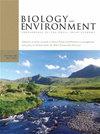北爱尔兰水獭lutra lutra的状况和饮食
IF 0.6
4区 环境科学与生态学
Q4 ENVIRONMENTAL SCIENCES
Biology and Environment-Proceedings of the Royal Irish Academy
Pub Date : 2022-01-01
DOI:10.3318/BIOE.2006.106.1.56
引用次数: 11
摘要
摘要/ Abstract摘要:2002年,我们对北爱尔兰水獭的状况和饮食进行了评估。在调查的441个地点中,65%的地点发现了水獭存在的迹象。这一数字表明,自20世纪80年代以来,水獭的数量有所下降。水獭的迹象在湖泊周围出现的频率最高,沿海地区出现的频率最低。水獭迹象的出现百分比在不同的集水区差异很大。水平最高的是弗马纳郡的梅尔文湖和伦敦德里郡的福伊尔集水区周围;安特里姆海岸出现的迹象最少。水獭出现的迹象在较大的河流和未受污染的地点(68%)高于受污染的地点(57%)。超过50%的水獭是由棘鱼(Gasterosteus aculeatus)、鲑科和鲤科组成,其中棘鱼是最常见的猎物类别。在所有陆地类别的水獭饮食中,从较小的溪流中收集的样本中发现鳗鱼(安圭拉安圭拉)的出现频率始终较高。除鲑科鱼外,大多数猎物的出现频率在不同的集水区有显著差异,鲑科鱼在北爱尔兰所有集水区收集的样本中一致出现。目前的调查证实,水獭在北爱尔兰仍然广泛存在。然而,水獭可能会以利润较低的猎物为食。为了充分了解影响北爱尔兰水獭饮食的因素,需要进一步研究水质、猎物可得性和猎物选择之间的关系。本文章由计算机程序翻译,如有差异,请以英文原文为准。
STATUS AND DIET OF THE OTTER LUTRA LUTRA IN NORTHERN IRELAND
Abstract:We assess the status and diet of otters in Northern Ireland in 2002. Signs of otter presence were noted at 65% of 441 sites surveyed. This figure suggests a decline in signs of otters since the 1980s. Highest occurrence of signs of otters was around lakes, with coastal sites having the lowest occurrence. Percentage occurrence of signs of otter varied considerably with respect to catchment. The highest levels were in Lough Melvin, County Fermanagh, and around the Foyle catchment, County Londonderry; fewest signs occurred along the Antrim coast. Signs of otter occurrence were higher in larger rivers and at unpolluted sites (68%) as compared to polluted sites (57%). Over 50% of otter spraints were composed of stickleback (Gasterosteus aculeatus), salmonids and cyprinids, with stickleback constituting the most frequently occurring prey category. The frequency of occurrence of eels (Anguilla anguilla) in otter diet was found to be consistently higher in spraints collected from smaller streams across all land class groups. The frequency of occurrence of most prey items differed significantly with catchment with the exception of salmonids, which occurred consistently in spraints collected throughout all catchments in Northern Ireland. The current investigation confirms that otters remain widespread in Northern Ireland. However, otters may be feeding on less profitable prey items. Further investigations into the relationship between water quality, prey availability and prey selection are required to fully understand the factors affecting otter diet in Northern Ireland.
求助全文
通过发布文献求助,成功后即可免费获取论文全文。
去求助
来源期刊
CiteScore
1.10
自引率
0.00%
发文量
6
审稿时长
>36 weeks
期刊介绍:
The journal aims to offer a broad coverage of the subject area, including the following:
- biology and ecology of the Irish flora and fauna
- microbial ecology
- animal, plant and environmental physiology
- global change
- palaeoecology and palaeoclimatology
- population biology; conservation of genetic resources
- pollution and environmental quality; ecotoxicology
- environmental management
- hydrology
- land use, agriculture, soils and environment.
Submissions on other relevant topics are also welcome, and papers of a cross-disciplinary nature are particularly encouraged.

 求助内容:
求助内容: 应助结果提醒方式:
应助结果提醒方式:


